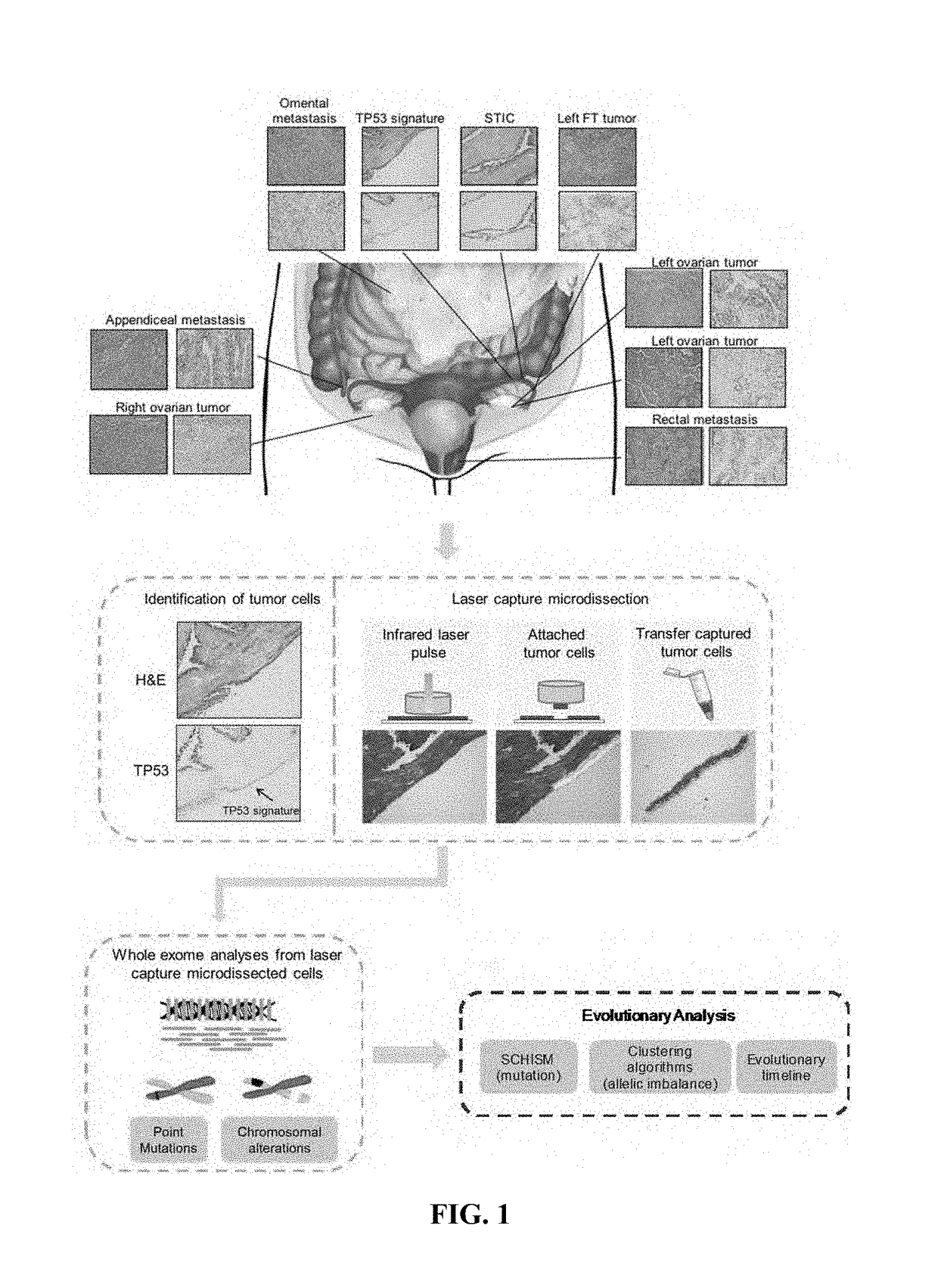Ovarian carcinoma detection and prophylaxis
a technology for ovarian cancer and detection and prophylaxis, applied in the field of cancer, can solve the problems of ovarian cancer, limited understanding of the natural history of the disease, and not led to improved overall survival, and achieve the effect of reducing the risk of ovarian cancer
- Summary
- Abstract
- Description
- Claims
- Application Information
AI Technical Summary
Benefits of technology
Problems solved by technology
Method used
Image
Examples
example 1
Methods
Specimens Obtained for Sequencing Analysis
[0041]The study was approved by the Institutional Review Board at Brigham and Women's Hospital and all patients gave informed consent before inclusion. Two patients with stage III HGSOC, in whom a serous tubal in situ carcinoma (STIC) was identified in their fallopian tubes (FT), were included. In addition, two patients with BRCA deleterious mutation that underwent prophylactic bilateral salpingoophorectomy and in whom a STIC was identified in their FT were included. Formalin-fixed paraffin embedded (FFPE) blocks were retrieved from the pathology files at Brigham and Women's Hospital within the 3 months following surgical diagnosis and stored at 4° C. to slow down nucleic acids degradation. All the cases were reviewed by a gynecologic pathologist (MH and DL) that confirmed the diagnosis of STIC and / or TP53 signature in the FT. Slides from each FFPE block to microdissected, including early lesions, invasive tumors and metastases, were ...
example 2
Overall Approach
[0055]To elucidate the relationship among tumors in patients with HGSOC, we performed whole-exome sequencing of 28 samples from four patients with multiple ovarian cancer lesions (FIG. 11, Supplementary Table S1). We included two patients with stage IIIC HGSOC in whom STIC lesions were identified (FIG. 11). For Patient 1, we analyzed the ovarian tumor of the left ovary and lesions of the left fallopian tube, including a TP53 signature, one STIC lesion, and fallopian tube tumor (FIG. 1, FIG. 11). We also evaluated from this patient a tumor of the right ovary as well as rectal, appendiceal and omental metastases. For Patient 2, we analyzed the tumor of the right ovary, lesions from the right fallopian tube including a TP53 signature, three different STIC lesions, a fallopian tube tumor, and lesions of the rectum and sigmoid colon (FIG. 11). In addition, we included two patients (Patients 3 and 4) with germline pathogenic BRCA mutations that underwent prophylactic bilat...
example 3
Analysis of Sequence Changes
[0057]Using a high-sensitivity mutation detection pipeline, we identified an average of 45 sequence alterations per sample. Candidate alterations were evaluated across samples in an individual to determine if they were present in multiple neoplastic lesions or were unique to a particular sample. To allow for the possibility that a subclone may have developed in a tumor lesion prior to becoming a dominant clone at another location, we determined if genetic alterations that were present in one tumor were also present in a low fraction of neoplastic cells of other lesions. This method excluded potential artifacts related to mapping, sequencing or PCR errors, allowing specific detection of alterations present in >1% of sequence reads (See Materials and Methods for additional information).
[0058]Whole-exome sequence analyses of the ten tumor samples from Patient 1 identified somatic mutations that were present in all neoplastic samples analyzed as well as speci...
PUM
| Property | Measurement | Unit |
|---|---|---|
| temperature | aaaaa | aaaaa |
| temperature | aaaaa | aaaaa |
| time | aaaaa | aaaaa |
Abstract
Description
Claims
Application Information
 Login to View More
Login to View More - R&D
- Intellectual Property
- Life Sciences
- Materials
- Tech Scout
- Unparalleled Data Quality
- Higher Quality Content
- 60% Fewer Hallucinations
Browse by: Latest US Patents, China's latest patents, Technical Efficacy Thesaurus, Application Domain, Technology Topic, Popular Technical Reports.
© 2025 PatSnap. All rights reserved.Legal|Privacy policy|Modern Slavery Act Transparency Statement|Sitemap|About US| Contact US: help@patsnap.com



